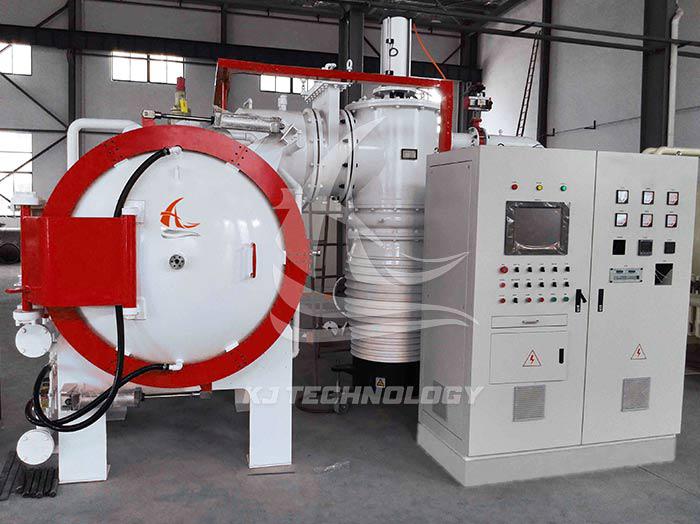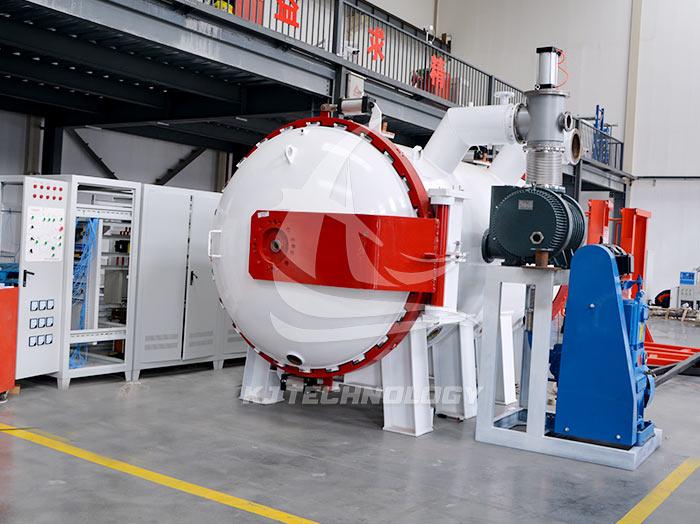Advantages of high vacuum and high temperature muffle furnace
 09-16-2025 Author: KJ technology
09-16-2025 Author: KJ technology
The high vacuum and high temperature muffle furnace combines high vacuum environment and high temperature processing capability, demonstrating significant advantages in materials science, industrial production, and scientific research analysis. Its core advantages can be analyzed from five dimensions: material protection, process control, experimental efficiency, safety and reliability, and wide application:
1. Ultimate Material Protection: Avoiding Oxidation and Pollution
Prevent oxidation and corrosion
The high vacuum environment (usually ≤ 10 ⁻ ³ Pa) significantly reduces the oxygen content in the furnace, effectively suppressing the oxidation reaction of materials such as metals and ceramics at high temperatures. For example, when sintering metal powder at 1600 ℃, a vacuum environment can prevent the formation of an oxide layer on the surface and ensure the purity of the material.
Suitable for oxygen sensitive materials such as titanium alloys and rare earth elements, to prevent their reaction with oxygen, nitrogen, etc. to generate impurity phases.
Reduce volatile pollution
Vacuum environment can reduce the volatilization rate of low boiling point elements (such as zinc and lead) in materials and avoid component segregation. For example, when sintering zinc containing ceramics, vacuum conditions can reduce zinc loss and ensure accurate stoichiometry.
Prevent residual gases (such as water vapor and carbon dioxide) in the furnace from contaminating the sample, especially suitable for high-purity fields such as semiconductors and optical materials.
2. Precise process control: optimizing material properties
Accurate temperature control and uniform heating
Equipped with high-precision temperature sensors (such as S-type thermocouples) and PID controllers, the temperature fluctuation range can be controlled within ± 1 ℃, supporting complex processes such as programmed heating and constant temperature maintenance.
The furnace adopts a multi-layer ceramic fiber or alumina fiber structure, combined with a reasonably designed heating element layout, to achieve temperature field uniformity (temperature gradient ≤ 5 ℃), ensuring that all parts of the sample are heated uniformly.
Controllable atmosphere and pressure regulation
Support optional atmosphere control systems (such as inert gas (Ar, N ₂) protection, vacuum inflation cycle), which can simulate different environmental conditions (such as reducing atmosphere, inert atmosphere).
By adjusting the vacuum degree and gas flow rate, the surface reaction rate of the material can be controlled, and the microstructure (such as grain size and porosity) can be optimized. For example, in the graphitization process of carbon materials, a vacuum environment can promote carbon atom rearrangement and increase the degree of graphitization.
3. Efficient experimental process: shorten the cycle and reduce costs
Rapid temperature rise and fall
The heating rate can reach 20 ℃/minute, and some models are equipped with rapid cooling devices (such as air-cooled and water-cooled), which can greatly shorten the experimental period. For example, it only takes 1 hour to raise the room temperature to 1600 ℃ and 2 hours to cool down to below 200 ℃.
Reduce energy consumption and lower operating costs (such as electricity expenses).
Non polluting treatment
Vacuum environment does not require the use of protective gases (such as hydrogen and argon) to avoid gas costs and subsequent processing (such as gas recovery and purification).
There is no combustion process or exhaust gas emission in the furnace, which meets environmental protection requirements.
4. Safety and reliability: ensuring operation and equipment lifespan
Multiple security protections
Equipped with overheat protection, leakage protection, vacuum interlock protection and other functions, when the temperature exceeds the limit, the vacuum degree is insufficient, or the furnace door is not closed, the power will be automatically cut off and an alarm will be triggered.
The furnace body is designed with a metal shell and insulation material, with a low surface temperature (usually ≤ 60 ℃), reducing the risk of burns.
Long lifespan and low maintenance
Heating elements (such as silicon molybdenum rods) have a low oxidation rate in a vacuum environment and a lifespan of over 2000 hours (only about 500 hours in an air environment).
Furnace materials (such as alumina fibers) are resistant to high temperatures and thermal shock, reducing the risk of cracking and lowering the frequency of replacement.
5. Wide applicability: meeting diverse needs
Scientific research field
Material synthesis: preparation of nanomaterials, composite materials, high-temperature superconducting materials, etc.
Performance testing: Study the high-temperature stability, phase transition behavior, thermal expansion coefficient, etc. of materials.
Simulation experiment: Simulate the space environment (high vacuum, low temperature) or geological processes (high temperature and high pressure).
industrial production
Metallurgical industry: metal melting, casting, heat treatment (such as annealing, quenching, aging treatment).
Ceramic glass: ceramic sintering, glaze melting, glass forming and annealing.
New energy: Developing battery materials (such as positive electrode materials, solid electrolytes) and catalyst carriers.
laboratory analysis
Sample pretreatment: ashing and pyrolysis of organic matter to provide pure samples for subsequent analysis (such as XRD, SEM, ICP-MS).
Elemental analysis: Determine the volatile components (such as sulfur and chlorine) in materials through high-temperature volatilization method.
6. Typical application cases
Post processing of metal 3D printing
Vacuum high-temperature sintering can eliminate pores in 3D printed metal parts, improve density, and avoid performance degradation caused by oxidation.
Semiconductor Device Packaging
Performing chip sintering in a vacuum environment can prevent metal lead oxidation and improve packaging reliability (such as reducing contact resistance and minimizing failure risk).
Preparation of carbon fiber composite materials
Vacuum high-temperature graphitization treatment can improve the modulus and conductivity of carbon fibers, which is suitable for fields such as aerospace and new energy vehicles.








